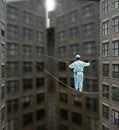Writing as a Process of Discovery
Wednesday's Writing on Writing
About half the novelists I know are outliners, and half are not. Some need the safety net of an outline.  Some outline so completely that the writing becomes filling in the blanks, yet somehow it works.
Some outline so completely that the writing becomes filling in the blanks, yet somehow it works.
I prefer to write as a process of discovery.
I try to put interesting characters in difficult situations and write to find out what happens. If the story surprises and delights or shocks and scares me, it should have the same effect on the reader.
The last thing a novelist wants to be is predictable, and if you're not sure what's going to happen until it happens, the reader sure won't be either.
If a scene seems to stall, I remind myself that conflict is the soul of fiction. Say you write a conversation designed to give the reader important information. If it feels flat, have one character suddenly disagree or even insult the other.
"Of course you'd say that; that's the way you've always felt. If it were up to you, you'd let her get away with murder."
The other character is going to respond defensively, maybe with anger. And suddenly the scene is alive again.
Give your characters opposing goals or opinions, and let the consequences play out in your mind, recording them as you go.
How much better to follow the story than to contrive it.
Sometimes I make a note or two to remind myself to finish a thought or a puzzle so I don't wind up with loose ends, but that's as close as I come to an outline.
I began Left Behind with the line, "Rayford Steele's mind was on a woman he had never touched." I then immediately establish that he is piloting a 747, has a wife and kids, and yet is daydreaming about a possible affair. That's on the edge of risqué for a novel in the inspirational market, and while I did not pursue any graphic details, you can see how that juxtaposition alone gave the reader enough to stay curious — and seemed to help the novel succeed.
Above all, give the reader credit and let him figure some things out for himself.
Show, don't tell, but don't show everything.
A Hemingway novel begins with a woman cutting bread and a boy delivering the Paris Review on cobblestone streets. Papa H. didn't have to come right out and say where the story was set.
Avoid clunky exposition; strive for subtlety. And write as a process of discovery.
It's a lot of fun — like reading and writing at the same time.



